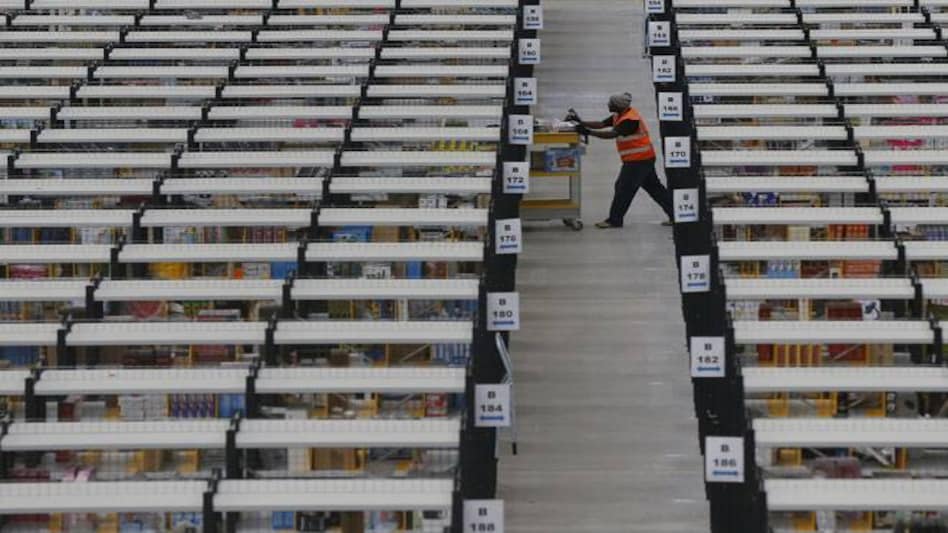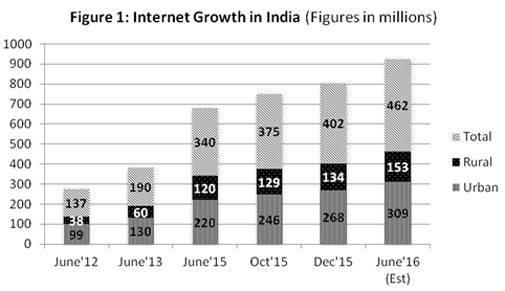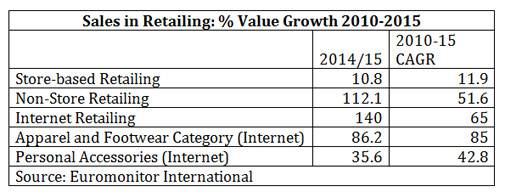


With global media exposure and rising aspirations, Indian customers have been looking for getting their hands on global fashion brands. While the customers have been ready, retailers have not been able to reach out to the customers in large part of the country due to limited and expensive retail space. Online fashion marketplace start-ups like Myntra, Jabong, FashionandYou, Limeroad, Voonik etc. grabbed this opportunity by bringing global brands at attractive (read discounted) prices. Increasing penetration of internet and mobile internet helped the cause and facilitated the growth of online retail (See Internet Growth in India). Investors, who saw great potential in emerging middle-class aspirations and increasing disposable incomes, funded these start-ups. Lifestyle e-retailers like Flipkart and Amazon also saw huge potential in fashion category and joined the bandwagon by promoting such merchandise. Indian ethnic fashion marketplace players like Jaypore, Craftsvilla etc. followed this by offering Indian handcrafted merchandise to attract a section of customers looking for exclusive ethnic fashion. Customers in tier-II and tier-III cities, who had the aspirations and purchasing power but did not have the access, have been driving the growth of online retail. For leading e-retailers including eBay, Snapdeal, and Myntra around 50 per cent of their business comes from these cities.

Internet retailing had a dream run in last few years showing a CAGR of 65 per cent in the 2010-2015 period as against a CAGR of 11.9 per cent in the store-based retailing during the same period. Among the online retail, too, apparel and footwear categories lead the deck with a CAGR of 85 per cent (Source: Euromonitor International).

Large corporates in brick-and-mortar retail space, who were sitting on the fence watching the game from a distance, finally realised the potential of online marketplace as a vehicle to reach out to a larger customer base in tier-II and tier-III cities where the retail space was limited. Aditya Birla Group, which is one of the India's largest fashion player with brands like Louis Philip, Van Heusen, Allen Solley and retail chain Pantaloons, entered online retail space by launching fashion portal abof.com last year. Abof.com sells a large number of Indian and international brands including some of the parent group offerings. To provide a differential experience to its customers, abof.com designed 3D virtual trial room where customers can instantly view themselves in any product by inputting their basic body proportions - first-of-its-kind in India. Reliance Retail, another large organised player in store-based retailing space - launched ajio.com to bring several national and international brands including merchandise from Marks and Spencers and their own brand AJIO. Further, they launched an exclusive collection of ethnic Indian merchandise handcrafted by artisans across the country under a collection called Indie. This allowed them to offer curated exclusive ethnic merchandise to customers who are ready to pay a premium and are not necessarily looking for discounts. The latest to join the bandwagon is Tata group, which is a prominent player in retail space with fashion and lifestyle retail chains like Westside and Croma and leading brands like Titan and Tanishq. Tata Unistore launched Tatacliq.com where they used the online platform to sell merchandise from their own chains as well as other brands in fashion and lifestyle space. TataCliq looked at some of the common issues in online marketplaces like fake merchandise and came up with the promise of authentic merchandise titled as C.A.M.E.L.S. - Certified Authentic Merchandise Everybody Loves.
However, recent times don't seem as rosy as they were a couple of years ago. Online retailers, who until now were chasing customers by offering unsustainable discounts, are under pressure to show profitability now. Funding is drying for many small players in this space. Smaller e-tailers like Freecultr, Zovi, Fashionera are finding it difficult to raise more money and either scaling down or looking at winding up. Jabong's acquisition by Myntra is just the beginning. While the sector is likely to continue to grow at a pace higher than brick-and-mortar retail, the growth rates are going to come down. The sector is likely to see a lot of consolidations and closure of small players. More store-based retail players will get into online space to have omnichannel presence to build up on their existing strengths. The online retail space in the coming future would be dominated by few large pure-play internet retailers and some corporate houses with established retail presence in the brick-and-mortar space.
The author is Assistant Professor, Marketing - SPJIMR (The views expressed are her own and not necessarily those of Business Today)
Copyright©2024 Living Media India Limited. For reprint rights: Syndications Today